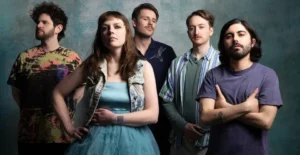What the heck is GEO and why do creatives need it?


Image licensed via Adobe Stock
The new digital frontier where AI meets creativity demands your urgent attention and strategic adaptation. We unpack why GEO is taking over from SEO and how creatives should respond.
Meet Sarah. She’s been running her branding studio for eight years. She’s brilliant at what she does—creating logos that make startups look like they’ve been around forever and crafting brand identities that actually mean something. But lately, she’s been staring at her Google Analytics dashboard with growing panic.
Once, her SEO game was solid. She’d write blog posts about “brand identity mistakes” and “logo design trends,” sprinkle in the right keywords, and watch clients trickle in. Not any more. Her organic traffic has nosedived, and frankly, she’s starting to wonder if anyone even clicks on Google results these days.
Here’s what Sarah is starting to realise: her potential clients aren’t Googling “brand designer London” any more. They’re asking ChatGPT, “Find me a brand designer”, or telling Claude, “I need help with my startup’s visual identity.” And guess whose expertise isn’t showing up in those AI responses? Sarah’s.
Welcome to the era of GEO, where the rules of getting discovered have completely changed, and most creatives are still playing by the old playbook.
What the hell is GEO anyway?
GEO stands for Generative Engine Optimisation, which sounds properly techy and intimidating, but it’s actually quite straightforward. It’s about making your content so darned good and well-structured that when someone asks an AI chatbot for advice in your area of expertise, the AI cites you as the go-to source.
Traditional SEO, also known as search engine optimisation, is about getting your website to rank high in search engine results. GEO is about getting your knowledge and expertise baked into the AI’s response itself. Instead of being link number seven on a Google results page, you become the expert the AI chatbot quotes directly.
The difference is massive. With SEO, people still had to click through to your site. With GEO, your insights are served up immediately, with your name attached, to potentially millions of people asking AI for creative advice. And here’s the kicker—it’s happening whether you’re participating or not. AI engines are already scraping content, synthesising it, and serving it up, even within the search engine pages themselves.
The question is: are you in that mix, or are you watching from the sidelines while your competitors become the default experts?
Why creatives are getting left behind
Let’s be honest: most of us creatives have a love-hate relationship with technology. We’re quick to embrace new design tools and creative software, but when it comes to the nuts and bolts of digital marketing, many of us would rather stick pins in our eyes.
SEO already felt like speaking a foreign language to most creatives. All that keyword research, meta descriptions, and link building—it was ‘necessary evil’ territory. But at least we figured it out eventually.
Now, the game has changed again, and frankly, a lot of us haven’t even noticed.
Meanwhile, 86% of direct-to-consumer advertisers plan to increase their use of AI for research and ideation in 2025. Your potential clients are increasingly turning to AI for everything from brainstorming sessions to finding service providers. And if you’re not showing up in those conversations, you’re becoming invisible.
The creative industry faces a particular challenge here because so much of what we do is visual, emotional and experiential. We’re used to our work speaking for itself. But AI engines can’t see your gorgeous portfolio or feel the emotional impact of your brand campaigns. They need structured, digestible information to understand and recommend your expertise.
The opportunity that’s hiding in plain sight
Here’s where it gets interesting. While most creatives are still figuring out Instagram Reels, there’s a massive opportunity to become the definitive expert in your niche through GEO.
Imagine this: when someone asks an AI system about rebranding strategies, logo design principles or creative campaign ideas, your insights are the first and most comprehensive response they get. Not just a link to your website—your actual expertise, quoted and credited, delivered directly to potential clients.
This isn’t just about visibility any more. It’s about establishing yourself as the authority that AI engines automatically turn to. And because most creatives haven’t caught onto this yet, there’s still time to claim your territory. Demand for skilled marketing and creative professionals remains strong midway through 2025; however, those who understand AI-driven discovery will have a significant edge. They’ll be the ones AI recommends when clients need creative expertise.
Your crash course in GEO for creatives
So, let’s get practical. How do you actually optimise for AI without losing your creative soul or spending your life writing boring, keyword-stuffed content?
First, stop thinking like a creative for a moment and start thinking like a teacher. AI engines love content that clearly explains processes, solutions and expertise. Instead of writing flowery case studies about your “journey of discovery” with a client (Creative Boom’s inbox is bulging with them), structure them like teaching materials.
Break down your projects into clear problems, solutions and outcomes. Instead of “We embarked on a transformative brand journey,” try “The client’s old logo was confusing customers about what they actually sold. We redesigned it to clearly communicate their core service, resulting in a 40% increase in enquiries.”
Create comprehensive guides that answer the questions your potential clients are actually asking. If you’re a brand designer, write detailed pieces about when companies should rebrand, how to brief a designer, or what makes a logo work. AI engines absolutely love this stuff.
Here’s the secret sauce: consistency and authority. When AI encounters multiple pieces of helpful content from the same source, all demonstrating genuine expertise, it starts to see you as the go-to expert in that area. It’s like building a reputation, but with robots.
And for the love of all that’s creative, use proper headings, bullet points and clear structure. AI engines need to understand your content hierarchy to extract and cite it properly. This doesn’t mean writing boring content; it means organising your brilliant insights in a way that both humans and AI can easily digest.
Like it or not, it’s happening
Reality check: the creative industry is changing whether we like it or not. The industry will need to work harder in 2025, but that’s a good thing. It’ll push the industry towards fresh and original thinking to stand out in an increasingly AI-mediated landscape.
Your potential clients are already using AI for research, inspiration and decision-making. They’re asking AI systems for creative advice, service recommendations and industry insights. If you’re not part of those conversations, you’re not part of their consideration set.
But here’s the thing. This isn’t about replacing your creativity with robot-friendly content. It’s about packaging your expertise in a way that AI can understand and share. Your creative insights, your unique perspective, and your hard-won expertise—that’s what makes you valuable. GEO just helps you get it in front of the right people.
The creative professionals who adapt now will establish themselves as the experts AI turns to before their competitors even understand what’s happening. And given how quickly AI adoption is accelerating, this window won’t be open forever.
Time to stop procrastinating
We get it. Another marketing acronym to learn, another digital strategy to master. It feels exhausting. But ignoring GEO is no longer a viable option. Generative Search Engine Optimisation is becoming an essential element of any digital strategy in 2025.
And let’s focus on the positive. The beautiful thing about GEO is that it’s not about gaming the system or stuffing keywords into your content. It’s about presenting your genuine expertise in a clear, structured way that both humans and AI can appreciate. It’s about being helpful, authoritative and accessible.
So start small. Pick one area of your expertise and create a comprehensive guide about it. Structure it clearly, make it genuinely useful, and optimise it for AI discovery. Then do it again. And again.
The creative industry has always been about adaptation and evolution. We survived the transition from print to digital, from static to interactive, from desktop to mobile. GEO is just the next evolution—one where understanding how AI discovers and shares creative expertise will separate the thriving studios from the struggling ones.
So what’s it going to be? Are you going to be like Sarah, watching your old SEO strategies slowly fail while your competitors claim the AI spotlight? Or will you seize this opportunity to become the creative expert that AI engines automatically recommend?
The choice is yours, but the clock is ticking.



